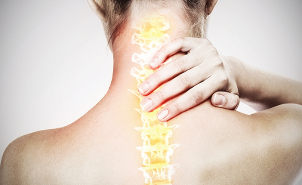
Today, cervical osteochondrosis is one of the most common diseases in people over 30 years of age. During the pathological process, the intervertebral disc and the vertebrae themselves are destroyed. After that, the disease attacks the vessels, tissues, ligament systems nearby.
A strong reason for the threat of this disease, doctors call lifestyle and work inactive.
In addition, the development of the disease is facilitated by:
- nervous stress, constant work;
- difficult physical work;
- overweight;
- dysfunction of the body's immune system;
- uncomfortable neck position during sleep;
- complications after infectious diseases.
Cervical osteochondrosis often develops in the elderly as a result of dementia changes in the body.
Cervical osteochondrosis has 4 degrees. This article will consider the symptoms and characteristics of treatment of stage 1 and 2 diseases, because in the stages of the consequences of the disease can be reversed, complex treatment can help well, including the use of drugs, traditional medicine, exercise, physiotherapy.
Stage 1 cervical osteochondrosis
Early signs of cervical osteochondrosis at stage 1 are weak. Often one does not pay attention to them ("his neck has been blown, it will pass by itself").
The body usually marks the onset of the disease as follows:
- neck pain, exacerbated by turning head;
- numbness and slight tingling in the arms and shoulders;
- general weakness of the body.
At the stage of the development of the disease, many in vain do not rush to see a doctor, who associates the disease with too much work, nervous stress.
The pathological process has just begun its destructive activity. The intervertebral disc does not lose its elasticity completely. Timely medical help will help prevent further progression of stage 1 osteochondrosis.
Methods of therapy in combination with massage, physiotherapy can restore the affected area, until complete healing.
Stage 2 cervical osteochondrosis

Late in seeking medical help requires the development of cervical osteochondrosis, the disease progresses to the second stage. Further destruction of the intervertebral disc occurs, the pathological process affecting the vertebrae itself and the tissues, the adjacent vessels.
Pinching the nerve roots causes the fact that the pain is not localized, but radiates to the arms, shoulders, back, below the scapula.
The patient goes to the cardiologist with a complaint of pain in the heart area. During the examination, it turned out that the cardiogram was within normal limits, and the painful sensation was caused by osteochondrosis.
Stage 2 cervical osteochondrosis manifests itself in the following symptoms:
- severe muscle pain in the neck;
- inability to turn, tilt, lift head;
- numbness in severe neck and upper shoulders;
- frequent headaches;
- high blood pressure consistently;
- performance decline;
- feeling tired constantly, feeling weak;
- pulls the pain radiating to the arm, under the shoulder blade, backwards;
- pain in the heart.
Constant tension of the back muscles is observed, resulting in vertebral displacement. This can cause curvature of the spinal space.
Treatment of the disease at this stage of development requires a more serious approach, including:
- drug therapy;
- medical and diagnostic examinations;
- physiotherapy;
- acupuncture;
- physiotherapy training;
- urut;
- strict diet;
- narrow specialist consultation (orthopedic, surgeon, neuropathologist).
A complete course of treatment is developed taking into account the patient's body characteristics, age, severity of the disease, the disease can last up to 2 months.
Prevention of cervical osteochondrosis stage 1 and 2
To prevent cervical osteochondrosis attacks, it is necessary to perform a group of preventive measures periodically.
The basic guidelines are as follows:

- Track your weight. Each extra kilogram increases the load on the spinal space. This will inevitably lead to loss of intervertebral disc elasticity, impaired blood circulation. The latter contributes to the occurrence of osteochondrosis.
- Try to move a lot. An uncertain lifestyle helps reduce muscle tone, all body systems begin to function for a while. Exercises in the fresh air, swimming, cycling, walking are very useful.
- Maintain proper body posture. Do not bend, straight back while walking while sitting at your desk. To do this, make it a rule to do some simple exercises every day.
- Choose a chair with backbone support for computer work. Get up from the table every half hour, do a little warm-up.
- Eliminates infectious focus in the body. Any infectious focus in the body can cause prerequisites for the occurrence of osteochondrosis of the cervical spine. This is especially true of ENT organs (ears, throat, nose).
- Correct body position during sleep and rest. It is recommended to use orthopedic mattresses and pillows. Their design ensures the correct position of the spine, allowing the body to rest as much as possible during rest.
- The daily physical exercise complex should include exercises for the prevention of osteochondrosis of the spinal canal.
- Proper nutrition. Do not use too much spicy, fatty and smoked foods. Try to include more vegetables, greens, fruits in your daily diet.
- Quit smoking and smoking. Now not only unhealthy, but also unattractive.
- undergoes a medical examination every year. Ultrasound, X-ray examination, tomography can detect the disease in the early stages of development.
Remember:your health is in your hands. Adhering to the simplest rules will allow your body to avoid serious diseases such as cervical osteochondrosis.

























